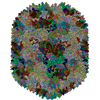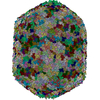+Search query
-Structure paper
| Title | Structures of a large prolate virus capsid in unexpanded and expanded states generate insights into the icosahedral virus assembly. |
|---|---|
| Journal, issue, pages | Proc Natl Acad Sci U S A, Vol. 119, Issue 40, Page e2203272119, Year 2022 |
| Publish date | Oct 4, 2022 |
 Authors Authors | Qianglin Fang / Wei-Chun Tang / Andrei Fokine / Marthandan Mahalingam / Qianqian Shao / Michael G Rossmann / Venigalla B Rao /   |
| PubMed Abstract | Many icosahedral viruses assemble proteinaceous precursors called proheads or procapsids. Proheads are metastable structures that undergo a profound structural transition known as expansion that ...Many icosahedral viruses assemble proteinaceous precursors called proheads or procapsids. Proheads are metastable structures that undergo a profound structural transition known as expansion that transforms an immature unexpanded head into a mature genome-packaging head. Bacteriophage T4 is a model virus, well studied genetically and biochemically, but its structure determination has been challenging because of its large size and unusually prolate-shaped, ∼1,200-Å-long and ∼860-Å-wide capsid. Here, we report the cryogenic electron microscopy (cryo-EM) structures of T4 capsid in both of its major conformational states: unexpanded at a resolution of 5.1 Å and expanded at a resolution of 3.4 Å. These are among the largest structures deposited in Protein Data Bank to date and provide insights into virus assembly, head length determination, and shell expansion. First, the structures illustrate major domain movements and ∼70% additional gain in inner capsid volume, an essential transformation to contain the entire viral genome. Second, intricate intracapsomer interactions involving a unique insertion domain dramatically change, allowing the capsid subunits to rotate and twist while the capsomers remain fastened at quasi-threefold axes. Third, high-affinity binding sites emerge for a capsid decoration protein that clamps adjacent capsomers, imparting extraordinary structural stability. Fourth, subtle conformational changes at capsomers' periphery modulate intercapsomer angles between capsomer planes that control capsid length. Finally, conformational changes were observed at the symmetry-mismatched portal vertex, which might be involved in triggering head expansion. These analyses illustrate how small changes in local capsid subunit interactions lead to profound shifts in viral capsid morphology, stability, and volume. |
 External links External links |  Proc Natl Acad Sci U S A / Proc Natl Acad Sci U S A /  PubMed:36161892 / PubMed:36161892 /  PubMed Central PubMed Central |
| Methods | EM (single particle) |
| Resolution | 3.4 - 5.1 Å |
| Structure data | EMDB-32103, PDB-7vrt: EMDB-32109, PDB-7vs5: |
| Source |
|
 Keywords Keywords | VIRUS / virus assembly / capsid expansion / capsid length control / prolate virus structure / virus decoration proteins / capsid stabilization |
 Movie
Movie Controller
Controller Structure viewers
Structure viewers About Yorodumi Papers
About Yorodumi Papers







 enterobacteria phage t4 (virus)
enterobacteria phage t4 (virus)